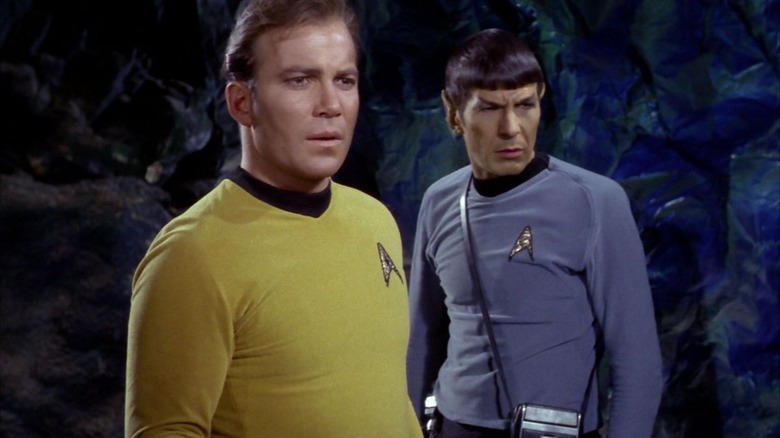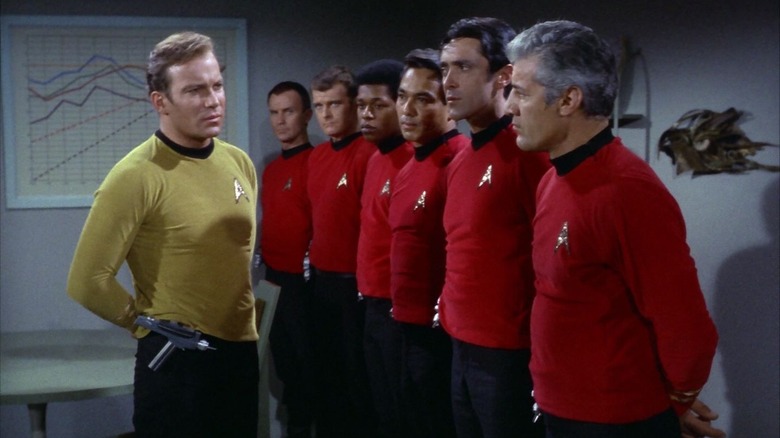William Shatner's Favorite Star Trek Episode Has A Major Problem
We may receive a commission on purchases made from links.
In the "Star Trek" episode "The Devil in the Dark" (March 9, 1967), the U.S.S. Enterprise visits a distant mining colony where the miners are being attacked and killed in the deep, subterranean tunnels by a mysterious creature. Captain Kirk (William Shatner) and Spock (Leonard Nimoy), sent to investigate, find that the creature can "burrow" through the rock using a naturally powerful acid, and that it seems to be deliberately destroying mining equipment, implying that it's intelligent. Eventually, Kirk and Spock find a mound-like animal called a horta, and Spock manages to mind-meld with it. The creature is able to burn words into a nearby rock, conforming its intelligence.
Kirk and Spock find that the horta wasn't killing miners out of malice, but to protect the thousands of horta eggs littering the tunnels. It seems that horta go nearly extinct every so often, and one is left alive to hatch a new generation. The miners and the horta learn to live together. It's a very "Star Trek" ending.
In his 1993 memoir "Star Trek Memories," William Shatner confessed that "Devil" was his favorite episode of the original series, as it was "exciting, thought-provoking, and intelligent." It had horror elements, a cool monster, a clever solution, and a very diplomatic ending emblematic of the series; the monster was merely misunderstood. "Devil" is typically listed as one of the show's best episodes overall, and the horta is one of the franchise's most notorious killer creatures.
There is one issue with "The Devil in the Dark," however: it's the only episode of "Star Trek" wherein none of the female characters have any speaking parts.
The Devil in the Dark has no speaking parts for the female Star Trek cast members
This was, of course, recognized, even at the time. "Star Trek" creator Gene Roddenberry, although a known womanizer, always wanted to feature women in more prominent roles on his series, and even cast Majel Barrett as the Enterprise's first officer in the show's original pilot. The show was eventually reworked, with only Nichelle Nichols remaining as one of the show's regular ensemble, and with Grace Lee Whitney as a recurring character (who was eventually cut). Barrett returned as Nurse Chapel, but that was it, apart from a rotating stable of guest stars.
When the network saw "The Devil in the Dark," they noted that the entire episode was about men. Kirk and Spock ordered around a bunch of male miners and male security officers. The episode's writer, "Star Trek" veteran Gene L. Coon, even wrote a letter to Roddenberry, discussing a note from NBC about the episode's absence of women. Coon had to remind Roddenberry that "Star Trek" was a gender-neutral utopia. The letter read:
"Per NBC's continual reminder to us, one which I find myself agreeing with, we should make some more use of females as crew members in planet stories, or find some way include females among groups of miners, who are here on a planet, years at a time. Granted again that this can get phony and unbelievable if not handled right, but let's keep in mind that we're in a century where women are granted equal status and responsibility with men. We should keep reminding the Assistant Directors of this and discuss same with Directors, so that they can oversee and control same."
Later "Star Trek" spin-offs would get a lot better about gender parity and including more female characters on dangerous away missions. And the newest spin-off, "Star Trek: Strange New Worlds" currently has three main male characters, and six main female characters. Back in the 1960s, though, even a progressive series like "Star Trek" needed to be reminded of its own utopian ideals.

